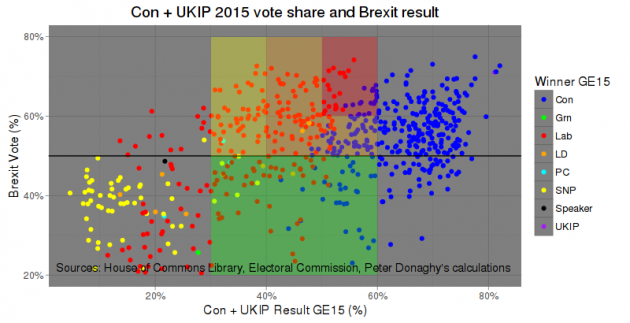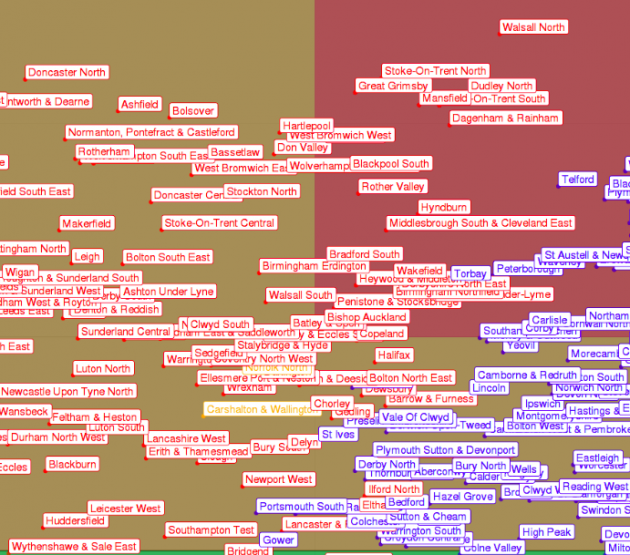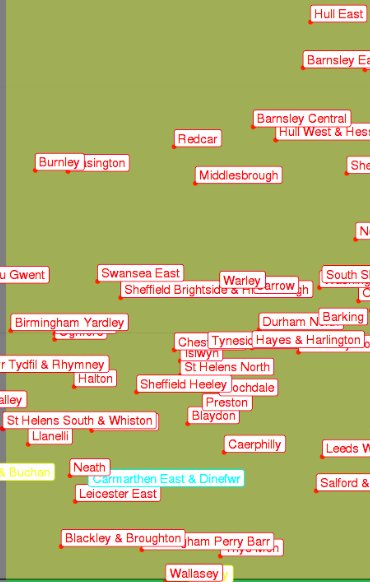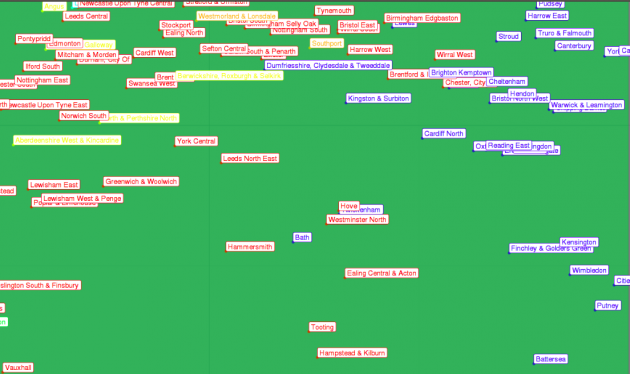The past days have seen a number of opinion polls released ahead of June’s General Election, and they continue to make grim reading for the Labour Party. The ComRes/Sunday Mirror poll gave the Conservatives a 50% share, double that of Labour on 25%. The last fortnight has continued to give Tories a vote share in the high forties, whilst Labour have been languishing far behind on the low to mid twenties.
Were these results to be replicated in the election itself, it would be catastrophic for Labour. In a First Past The Post Election, a party that captures an absolute majority of the popular vote could find itself winning a landslide greater than Labour managed under Tony Blair in 1997. In the 2015 General Election in Scotland, Labour polled 24.3% to the SNP’s 50%, and lost 40 of their 41 seats. There is no reason to believe Labour’s Scottish disaster could be replicated across vast swathes of Britain two years on.
To illustrate the predicament Labour find themselves in, the following chart shows all 632 constituencies in Great Britain, with the percentage of the electorate who voted to leave the European Union on the y-axis and the combined share for the Conservatives and Ukip on the x-axis. Ukip have themselves seen a serious setback in terms of their support since the Brexit referendum, and as all evidence appears to show that the majority of voters deserting Ukip are supporting the Conservatives.

I have highlighted four areas on the chart where Conservatives might expect to make gains. The area to the right can be considered entirely safe for the Conservatives, whilst the constituencies where the combined Tory & Ukip share was less than 30% in 2015 is presumably safe territory for Labour, the SNP, the handful of safe Lib Dem seats and the solitary safe seats for the Green Party and Plaid Cymru.
The green red area shows seats where the combined Ukip & Tory share in 2015 exceeded 50%, and where the electorate backed Brexit by 60% or more. It would be an impressive achievement if Labour held even a handful of these seats, all of which would appear to be lost causes if current polling is reflected in actual votes. There are 20 Labour seats with this profile.
After the red area, the L-shaped orange area is the next most likely area to see strong gains by the Conservatives. These are constituencies that voted Leave, and where the combined Ukip & Conservative vote exceeded 50%.
This is the region of the chart where Labour are defending the most seats (68). Were the Tories to sweep this area, then they would also gain two seats from the Liberal Democrats. Included in this area is the former constituency of Tony Blair, Sedgefield, and the seat of former Labour leader Ed Miliband in Doncaster North. The red and orange areas are shown in greater detail below.

The other two areas where Labour could be vulnerable are the yellow area, which voted Leave and where the combined Tory & Ukip share exceeded 30%; and the green area, which voted Remain and where the combined Tory & Ukip share was greater than 30%. The detail of these areas is shown below.


The yellow area contains 47 Labour seats, one Plaid Cymru seat and one Lib Dem, whilst the green area contains 48 Labour seats, two Liberal Democrats, six SNP seats and one Plaid Cymru.
An excellent night for Labour would see them containing losses to the 20 seats in the red area, whilst holding on elsewhere. However, if they start making serious losses in the orange region then they are in serious trouble. Should they also incur heavy losses in the yellow and green regions then the losses would be catastrophic.
If Labour defy the pollsters and only lose seats in the red region of the chart, then they will still have in excess of 200 MPs in the House of Commons. However, should the hitherto unthinkable happen and the Conservatives sweep every single seat in all four coloured areas of the map, then Labour would be left with 49 seats.
This would be worse than even their nadir in the 1931 General Election, when they won 52 seats. The General Election of December 1910 would be the last time Labour had a smaller representation in the Commons, when they won 42 seats and came fourth behind John Redmond’s Irish Parliamentary Party. Under this scenario the largest opposition party would be the SNP.
Polls such as the YouGov poll giving the Conservatives a ten point lead over Labour in Wales demonstrate that there are now very few Labour seats that are truly safe. Of the 232 constituencies that elected a Labour MP in 2015, 148 voted to leave the EU. And just because a constituency has been held by the party for decades does not mean that it can’t be swept away in a wave, as many former Scottish Labour MPs will be able to tell you.
The local elections on the 4th of May could provide a clue as to the fate awaiting Labour in June, and if there will be any individual constituency polling carried out this might provide some insight also. However on the night of the election, the usually safe Labour seats in Sunderland will provide an early glimpse of whether Labour are facing a merely bad night, or a cataclysmic one.
Data Sources:
EU Referendum data: House of Commons Library blog
General Election 2010 & 2015 results: Electoral Commission
The data used to create this analysis can be found as a Google Sheets spreadsheet here.
A qualified accountant and data analyst, interested in politics, economics and data. Twitter: @peterdonaghy
Discover more from Slugger O'Toole
Subscribe to get the latest posts to your email.